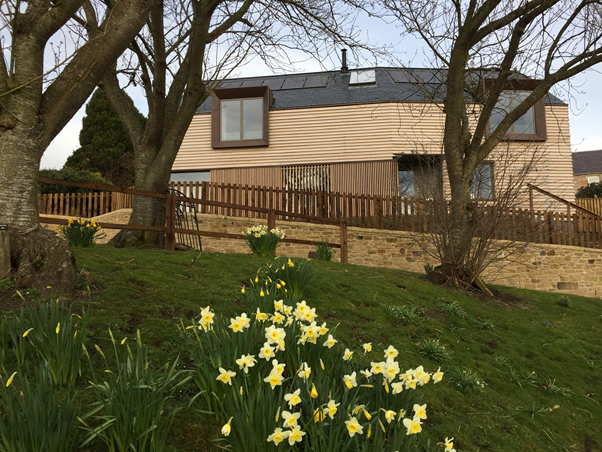
Building one's own eco-home
Picture2.png

Kate Atchley, an attender at Kelso meeting, has built her own eco-house. She loves it, but it was not all plain sailing …!
For some years, Kate lived in Ardnamurchan. But a move nearer her children gave her the lifetime opportunity to build a future-proofed, eco-friendly house in the Borders, completed in March 2020.
She has:
- 12 photovoltaic panels on the roof generating electricity. This is used first in the house and any excess flows into the national grid. Since January 2020 customers can arrange to be paid by their supplier for this “feed-in” but after many months of trying to arrange this with Scottish Power, Kate gave up and moved to Octopus who offer a better feed-in tariff and will fit the necessary smart export meter within a short time. Also, they buy only renewably-produced electricity and charge her less for it too.
- an air-source heat pump, extracting heat from the air to warm the house (the garden wasn’t big enough for a slightly more energy-efficient ground-source heat pump)
- triple glazing throughout
- vacuum sealing – this means that when the doors and windows are shut, the house is sealed
- an air ventilation system that recycles 88% of the heat from the outgoing air (from kitchen and bathrooms), to warm fresh drawn into living spaces and bedrooms.
- Kate also has a woodburning stove in case the electricity supply packs up. Only certain fuels will be permitted from 2022 and from then only wood burners that have passed stringent new European Eco Design regulations will be available for sale within Europe or the UK.
When she decided she would try to build from scratch, Kate looked at 15 plots over 2 days. The only one she liked was a south-facing plot overlooking the River Cheviot. It already had outline planning permission (though for a slightly smaller house than she finally built).
One the architect-designs were done, an appointed contractor (local) ran the project, undertaking all the groundwork, drainage, walls and hard surfacing. The rest – heating, roof panels, roofing, zinc cladding, joinery, plumbing, electrics, tiling – was sub-contracted locally. ‘Most of the guys’ she says, ‘liked the contemporary design of the house and everyone seemed eager to do their best work. I was very fortunate.’ Kate lived in a rented cottage nearby for 3 years before and during the build.
However there were hiccoughs and unexpected extra costs. The foundations had to be dug deeper than expected because the soft topsoil was deeper than expected. And an old drystone wall collapsed when the site was cleared. So a new wall was needed. The building inspector asked for fire-retardant paint on some surfaces only after they had been already painted. Delay in ordering high-quality kitchen cupboard doors resulted in a significant price leap.
Then there was the problem of draining water running off the roof and hard surfaces around the house. ‘Many drains around the country are old and a bit overwhelmed,’ says Kate. ‘Last winter was the wettest for 150 years – sign of climate change. There were reports of sewage overflowing into some rivers.’ To help mitigate these problems, new regulations now ban surface runoff being fed into the usual drains. The ground around the house was clay and non-porous so another solution was needed. Kate had hoped the runoff could be channelled into a nearby stream, but the local estate ‘requested too many noughts after the figure first thought of’. In the end, 40 drainage pipes of 40mm width were sunk 6 metres down under the clay topsoil to porous rock beneath – a costly exercise.
‘There were lots of snags; it was very stressful at times’, Kate says. ‘In the end, the house cost 160% of the original budget. Unless you have very deep pocket, I wouldn’t recommend embarking on a unique project like this. But there are well-designed kit houses from suppliers such as HebHomes and R.House which deliver eco-friendly solutions at much less cost.’
But she now loves it. And having chatted about bees and consumed lots of Kate’s honey during the build, her joiner has taken up beekeeping with a colony from Kate.
